Failure Characteristics and Cooperative Control Strategies for Gob-Side Entry Driving near an Advancing Working Face: A Case Study
Abstract
1. Introduction
2. Case Study
2.1. Field Background
2.2. Displacement Characteristics of Entry
3. Establishment of Numerical Analysis Model
3.1. Numerical Model and Simulation Scheme
3.1.1. Numerical Model
3.1.2. Numerical Simulation Scheme and Measurement Scheme
3.2. Numerical Simulation of Mechanical Properties of Rock
3.3. Double-Yield Model of Gob Area
3.4. Validation of Simulation Model Parameters
4. Simulation Results of Gob-Side Entry Driving NAWF
4.1. The Influence Range of 15101 Working Face Mining
4.2. Failure Characteristics of the Coal Pillar during Gob-Side Entry Driving NAWF
4.3. Determination of Coal Pillar Width
5. Cooperative Control Strategies of Gob-Side Entry Driving NAWF
5.1. Pressure Relief Scheme of Hydraulic Fracturing Roof Cutting
5.2. Determination of Dynamic Segmented Support Scheme
5.3. Field Effect
5.3.1. Hydraulic Fracturing Effect
5.3.2. Entry Displacement
6. Conclusions
Author Contributions
Funding
Data Availability Statement
Conflicts of Interest
References
- He, F.L.; Zhao, Y.Q.; Xie, F.X.; Liu, J. Instability mechanism and control of roadway subjected to severe mining dynamic load with double roadway layout mining face. Geotech. Geol. Eng. 2019, 37, 2985–2997. [Google Scholar] [CrossRef]
- Bai, J.B.; Shen, W.L.; Guo, G.L.; Wang, X.Y.; Yu, Y. Roof deformation, failure characteristics, and preventive techniques of gob-side entry driving heading adjacent to the advancing working face. Rock Mech. Rock Eng. 2015, 48, 2447–2458. [Google Scholar] [CrossRef]
- Huang, P.; Zhang, Q.; Xie, J.; Li, J.M.; Zhang, Q.; Li, M.; Simao, F.C. Multiscale study on coal pillar strength and rational size under variable width working face. Front. Environ. Sci. 2024, 12, 1338642. [Google Scholar] [CrossRef]
- Jiang, L.; Sainoki, A.; Mitri, H.S.; Ma, N.; Liu, H.; Hao, Z. Influence of fracture-induced weakening on coal mine gateroad stability. Int. J. Rock Mech. Min. Sci. 2016, 88, 307–317. [Google Scholar] [CrossRef]
- Chen, D.D.; Zhu, J.; Ye, Q.C.; Ma, X.; Xie, S.R.; Guo, W.K.; Yan, X.X. Application of gob-side entry driving in fully mechanized caving mining: A review of theory and technology. Energies 2023, 16, 2691. [Google Scholar] [CrossRef]
- Bai, J.B.; Hou, C.J.; Huang, H.F. Numerical simulation study on stability of narrow coal pillar of roadway driving along goaf. Chin. J. Rock Mech. Eng. 2004, 23, 3475–3479. [Google Scholar]
- Zhang, N.; Li, X.H.; Gao, M.S. Pretensioned support of roadway driven along next gob and heading adjacent advancing coal face and its application. Chin. J. Rock Mech. Eng. 2004, 23, 2100–2105. [Google Scholar]
- Wilson, A.H.; Ashwin, D.P. Research into the determination of pillar size. Min. Eng. 1972, 131 Pt 9, 141. [Google Scholar]
- Shabanimashcool, M.; Li, C.C. Numerical modelling of longwall mining and stability analysis of the gates in a coal mine. Int. J. Rock Mech. Min. Sci. 2012, 51, 24–34. [Google Scholar] [CrossRef]
- Salamon, M.D.G.; Munro, A. A study of the strength of coal pillars. J. S. Afr. Inst. Min. Metall. 1967, 68, 55–67. [Google Scholar]
- Wang, M.; Bai, J.B.; Li, W.F.; Wang, X.Y.; Cao, S.G. Failure mechanism and control of deep gob-side entry. Arab. J. Geosci. 2015, 8, 9117–9131. [Google Scholar] [CrossRef]
- Song, C.H.; Lu, C.P.; Zhang, X.F.; Wang, C.; Xie, H.D.; Yan, X.Y.; Yang, H.W. Moment tensor inversion and stress evolution of coal pillar failure mechanism. Rock Mech. Rock Eng. 2022, 55, 2371–2383. [Google Scholar] [CrossRef]
- Zhang, G.C.; Liang, S.J.; Tan, Y.L.; Xie, F.X.; Chen, S.J.; Jia, H.G. Numerical modeling for longwall pillar design: A case study from a typical longwall panel in China. J. Geophys. Eng. 2018, 15, 121–134. [Google Scholar] [CrossRef]
- Li, W.F.; Bai, J.B.; Peng, S.; Wang, X.Y.; Xu, Y. Numerical modeling for yield pillar design: A case study. Rock Mech. Rock Eng. 2015, 48, 305–318. [Google Scholar] [CrossRef]
- Wang, X.; Wu, Y.C.; Li, X.H.; Liang, S. Numerical investigation into evolution of crack and stress in residual coal pillars under the influence of longwall mining of the adjacent underlying coal seam. Shock Vib. 2019, 2019, 2094378. [Google Scholar] [CrossRef]
- Wu, W.D.; Bai, J.B.; Wang, X.Y.; Yan, S.; Wu, S.X. Numerical study of failure mechanisms and control techniques for a gob-side yield pillar in the Sijiazhuang coal mine, China. Rock Mech. Rock Eng. 2019, 52, 1231–1245. [Google Scholar] [CrossRef]
- Cheng, Y.M.; Wang, J.A.; Xie, G.X.; Wei, W.B. Three-dimensional analysis of coal barrier pillars in tailgate area adjacent to the fully mechanized top caving mining face. Int. J. Rock Mech. Min. Sci. 2010, 47, 1372–1383. [Google Scholar] [CrossRef]
- Li, W.F.; Bai, J.B.; Cheng, J.; Peng, S.; Liu, H. Determination of coal–rock interface strength by laboratory direct shear tests under constant normal load. Int. J. Rock Mech. Min. Sci. 2015, 77, 60–67. [Google Scholar] [CrossRef]
- Jaiswal, A.; Shrivastva, B.K. Numerical simulation of coal pillar strength. Int. J. Rock Mech. Min. Sci. 2009, 46, 779–788. [Google Scholar] [CrossRef]
- Li, Y.; Wang, N.; Lei, X.H.; Li, T.Z.; Ren, Y.Q.; Wang, X.Y. Stress Evolution of Repeated Mining Based on the Double-Yield Model in Multiple Coal Seam. Rock Mech. Rock Eng. 2024, 57, 2809–2827. [Google Scholar] [CrossRef]
- Yan, B.; Che, S.; Tannant, D.D.; Ren, F.; Wang, P. Application of double-yield model in numerical simulation of stability of mining filling body. Arab. J. Geosci. 2019, 12, 515. [Google Scholar] [CrossRef]
- Yu, Y.; Wang, X.Y.; Xu, G.Z. Dynamic sectional control technology of surrounding rock in gateway driving along goaf forward to mining face. Coal Sci. Technol. 2013, 41, 43–46. [Google Scholar]
- Wang, M.; Bai, J.B.; Wang, X.Y. The surrounding rock deformation rule and control technique of the roadway driven along goaf and heading for adjacent advancing coal face. J. Min. Saf. Eng. 2012, 29, 197. [Google Scholar]
- Shao, L.Y.; Huang, B.X.; Zhao, X.L.; Xing, Y.K. Criteria for the progressive initiation and propagation of radial and axial fractures of borehole during rock hydraulic fracturing. Energy Sources Part A Recovery Util. Environ. Eff. 2020, 1–17. [Google Scholar] [CrossRef]
- Chen, J.C.; Qu, Z.Z.; Zhou, L.; Su, X.P. Numerical study on the hydraulic fracturing pattern in the hard roof in response to mining-induced stress. Minerals 2023, 13, 308. [Google Scholar] [CrossRef]
- Yang, X.J.; Liu, C.K.; Ji, Y.; Zhang, X.Y.; Wang, S. Research on roof cutting and pressure releasing technology of directional fracture blasting in dynamic pressure roadway. Geotech. Geol. Eng. 2019, 37, 1555–1567. [Google Scholar] [CrossRef]
- Kang, H.P. Seventy years development and prospects of strata control technologies for coal mine roadways in China. Chin. J. Rock Mech. Eng. 2021, 40, 1–30. [Google Scholar]
- Lv, W.D.; Zhao, N.N. Research on Supporting Technology of Roadway Driving along next goaf of second mining strip pillar. Adv. Mater. Res. 2012, 446, 1657–1660. [Google Scholar]
- Wang, Q.; Jiang, B.; Wang, L.; Liu, B.H.; Li, S.C.; Gao, H.K.; Wang, Y. Control mechanism of roof fracture in no-pillar roadways automatically formed by roof cutting and pressure releasing. Arab. J. Geosci. 2020, 13, 274. [Google Scholar] [CrossRef]
- Wang, M.Z.; Zheng, H.H.; Ma, Z.Q.; Mu, H.; Feng, X.L. Control technology of roof-cutting and pressure relief for roadway excavation with strong mining small coal pillar. Sustainability 2023, 15, 2046. [Google Scholar] [CrossRef]
- Gong, P.; Chen, Y.H.; Ma, Z.G.; Cheng, S.X. Study on stress relief of hard roof based on presplitting and deep hole blasting. Adv. Civ. Eng. 2020, 2020, 8842818. [Google Scholar] [CrossRef]
- Tang, Y.S.; Sun, W.C.; Zhang, X.; Liu, P.J. Effect of advancing direction of working face on mining stress distribution in deep coal mine. Adv. Civ. Eng. 2021, 2021, 7402164. [Google Scholar] [CrossRef]
- Zhu, D.F.; Yu, B.B.; Wang, D.Y.; Zhang, Y.J. Fusion of finite element and machine learning methods to predict rock shear strength parameters. J. Geophys. Eng. 2024, gxae064. [Google Scholar] [CrossRef]
- Mohammad, N.; Reddish, D.J.; Stace, L.R. The relation between in situ and laboratory rock properties used in numerical modelling. Int. J. Rock Mech. Min. Sci. 1997, 34, 289–297. [Google Scholar] [CrossRef]
- Cai, M.F.; He, M.C.; Liu, D.Y. Rock Mechanics and Engineering, 2nd ed.; Science Press: Beijing, China, 2013. [Google Scholar]
- Mark, C. Pillar Design Methods for Longwall Mining; US Department of the Interior. Bureau of Mines: Washington, DC, USA, 1990; Volume 9247. [Google Scholar]
- Li, M.; Zhang, J.X.; Huang, P.; Zhang, Q.; Wu, Z.Y. Parameters updating and calibrated double-yield model methods to simulate the compaction behaviour of waste rock backfill materials in coal mine gob. Q. J. Eng. Geol. Hydrogeol. 2022, 55, 2021–2096. [Google Scholar] [CrossRef]
- Gong, P.L.; Jin, Z.M. Study on the structure characteristics and movement laws of overlying strata with large mining height. J. China Coal Soc. 2004, 29, 7–11. [Google Scholar]
- Asef, M.R.; Reddish, D.J.; Lloyd, P.W. Rock–support interaction analysis based on numerical modelling. Geotech. Geol. Eng. 2000, 18, 23–37. [Google Scholar] [CrossRef]

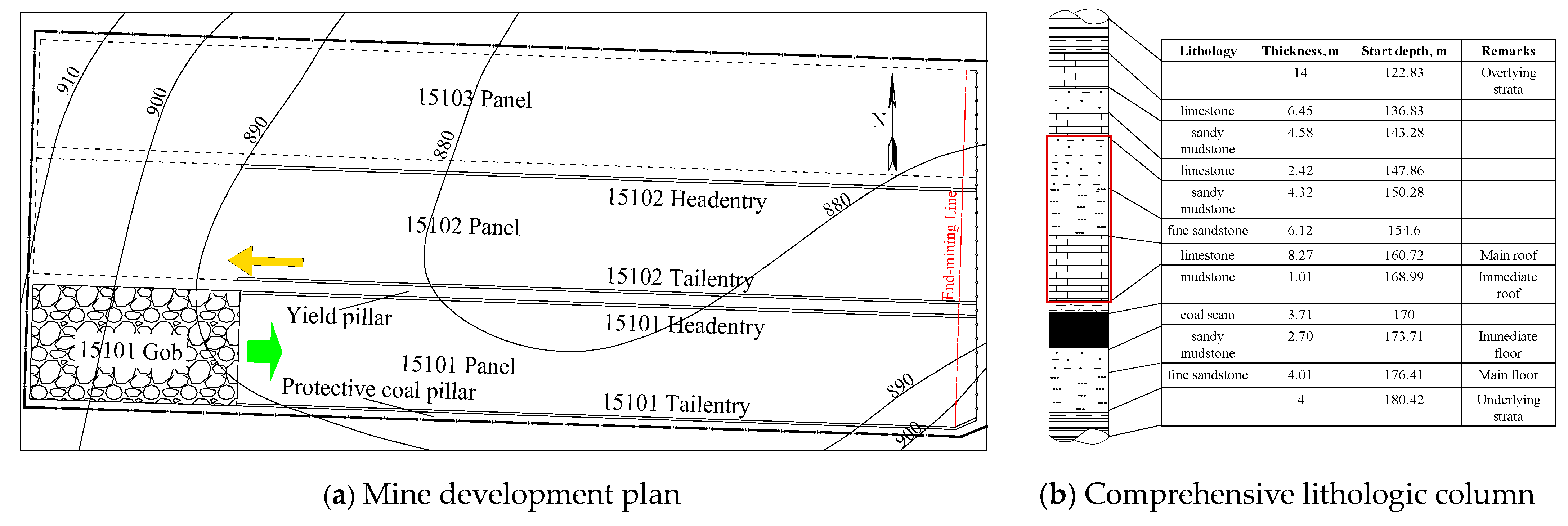

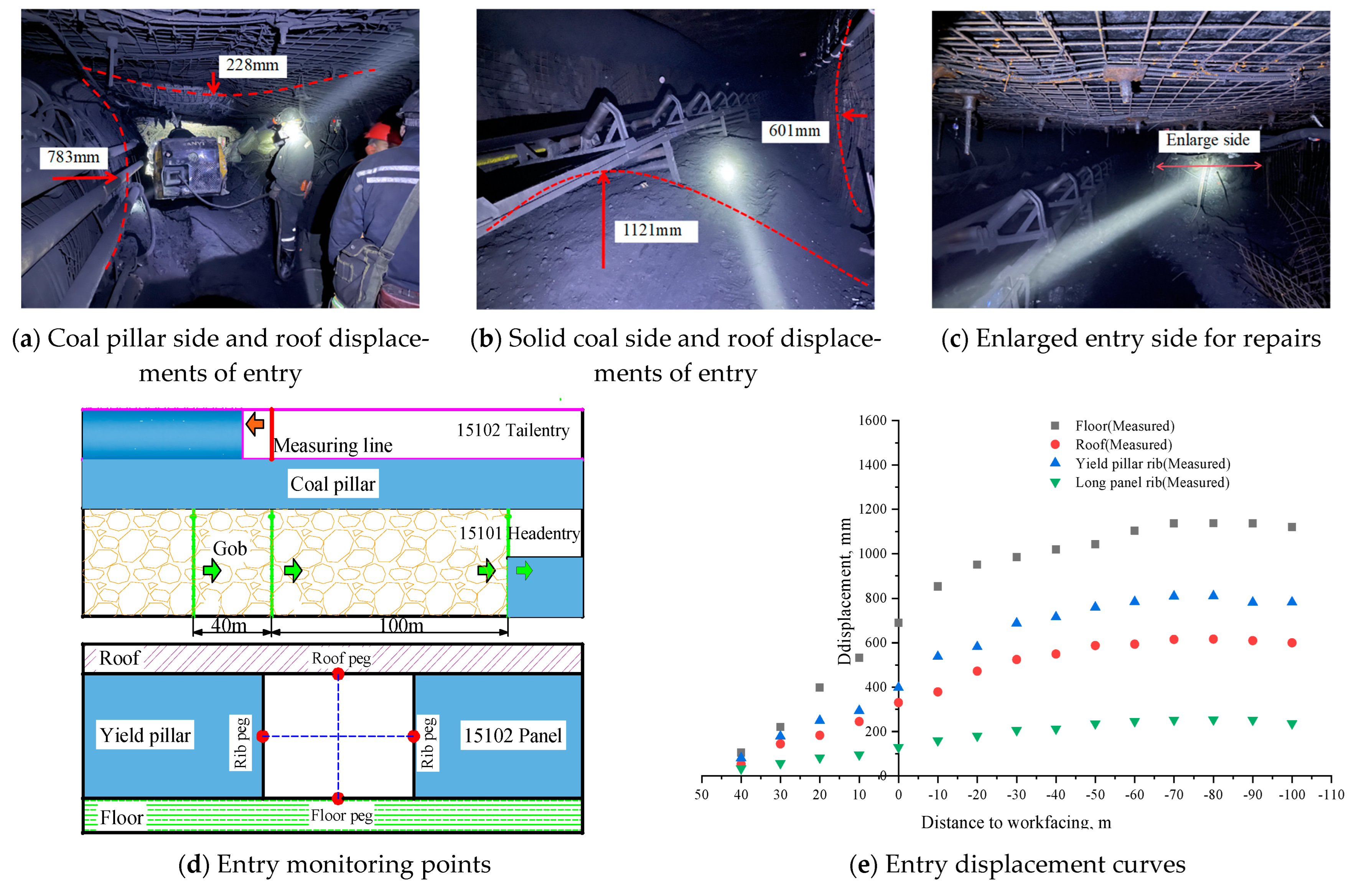
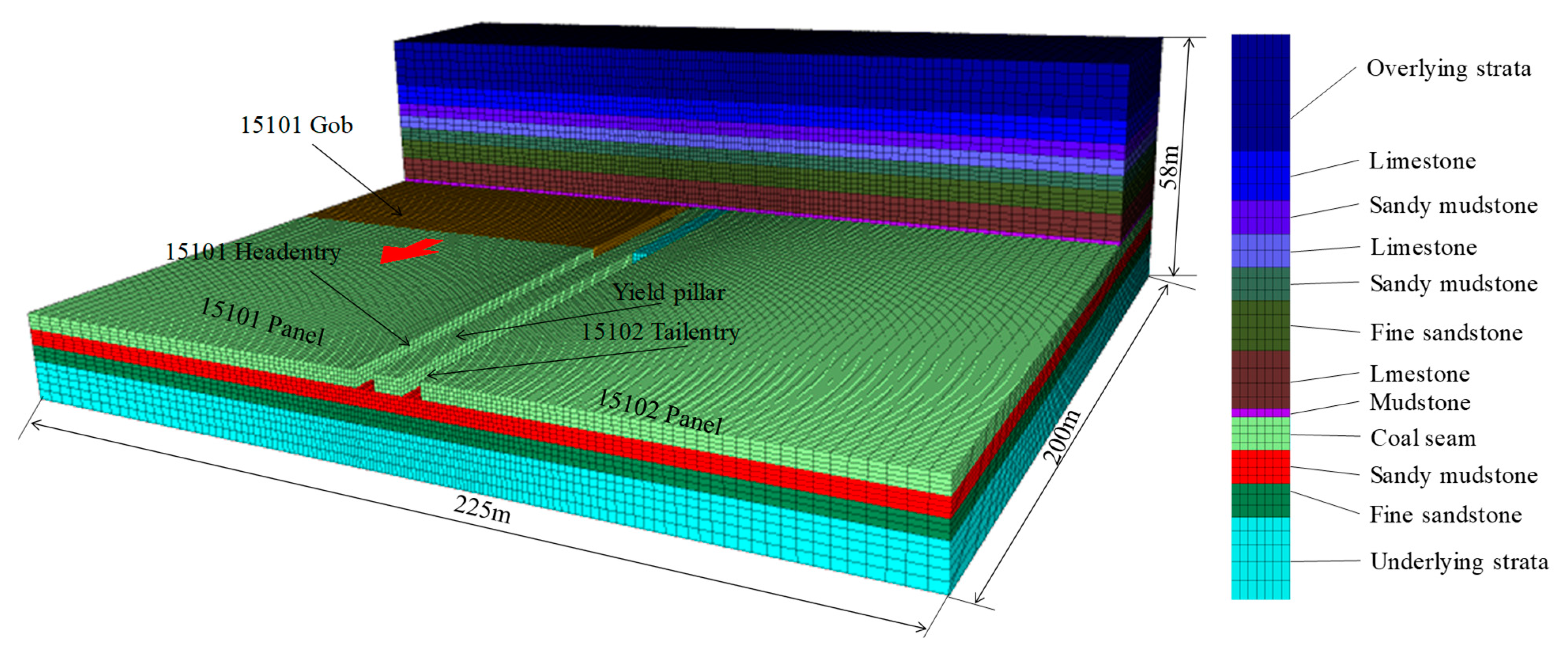

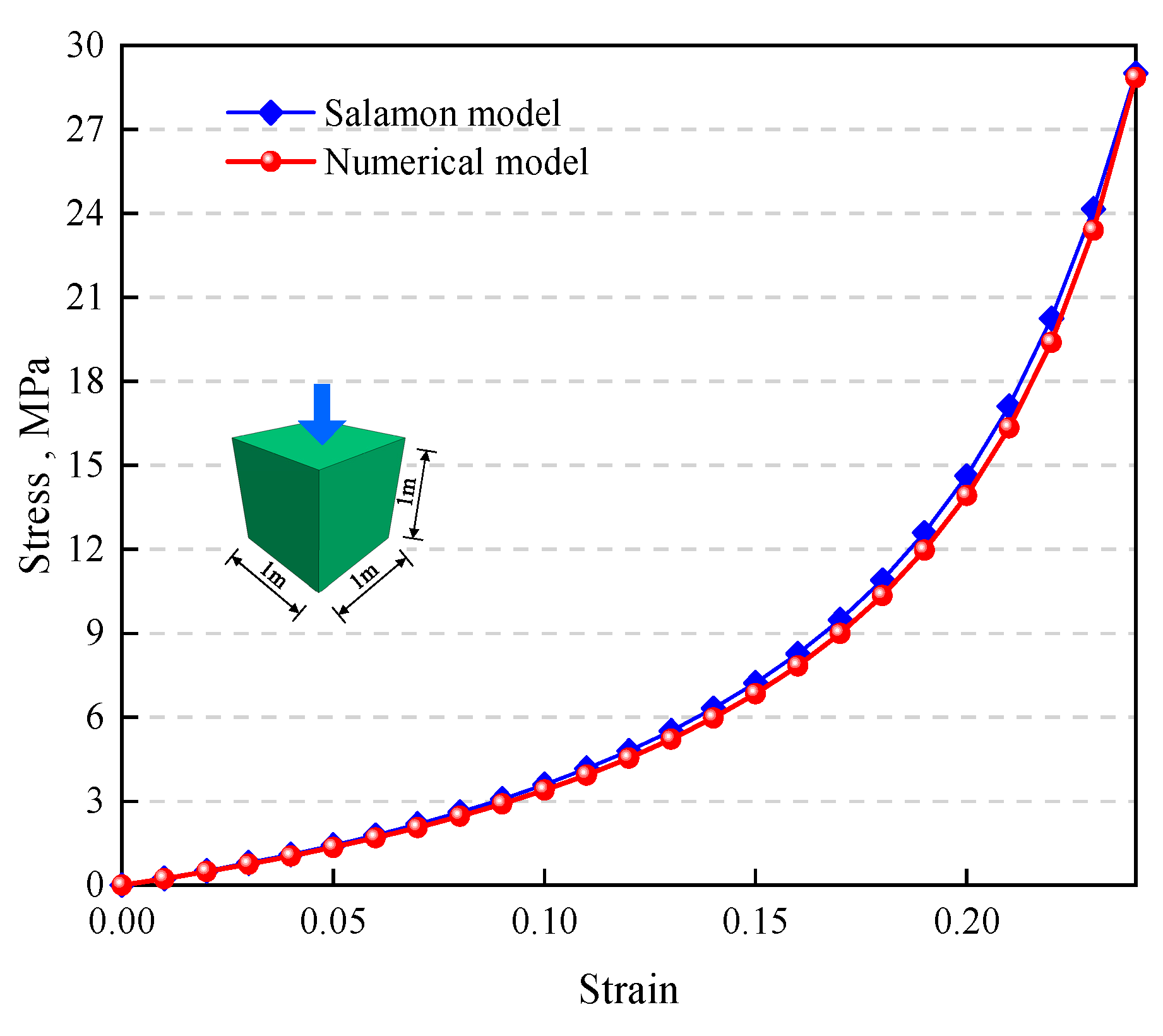
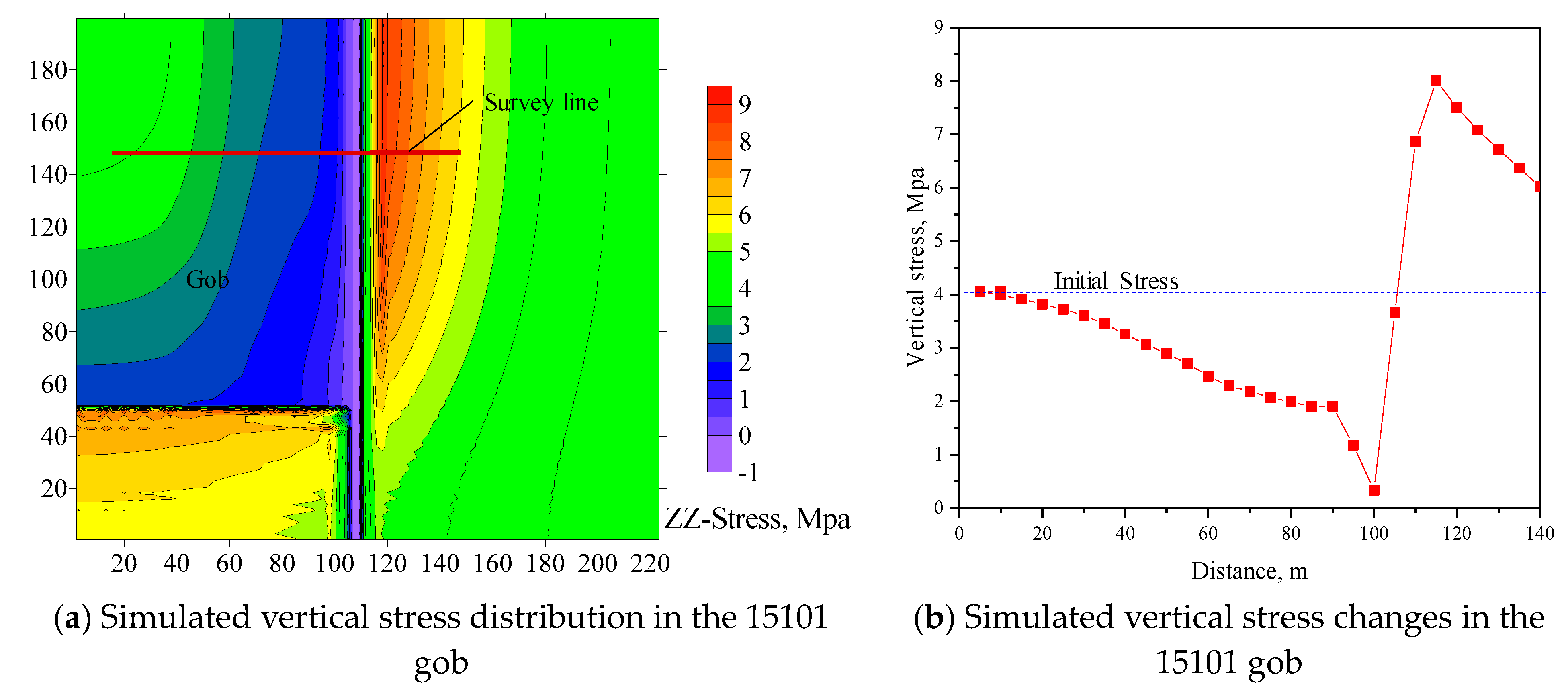

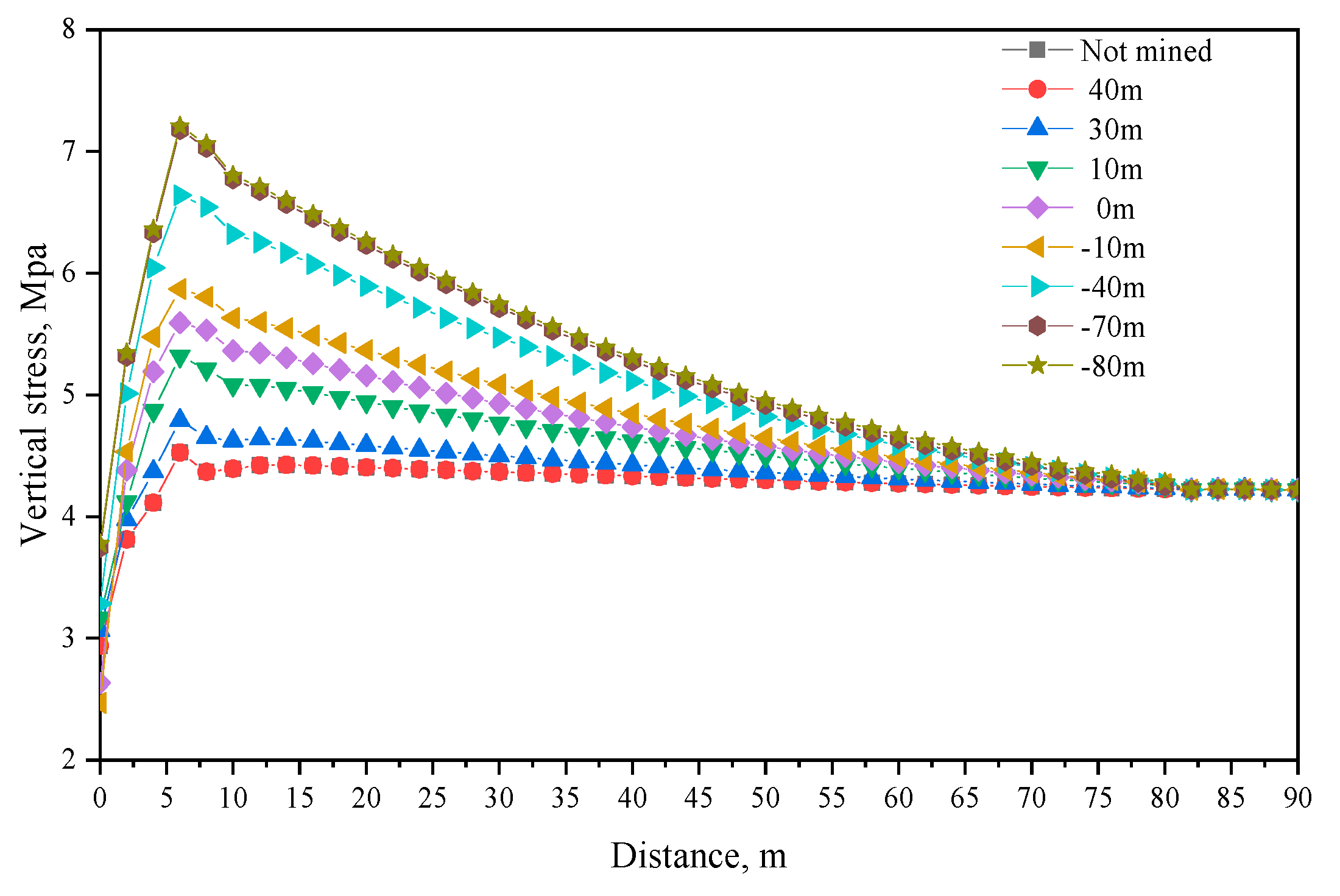
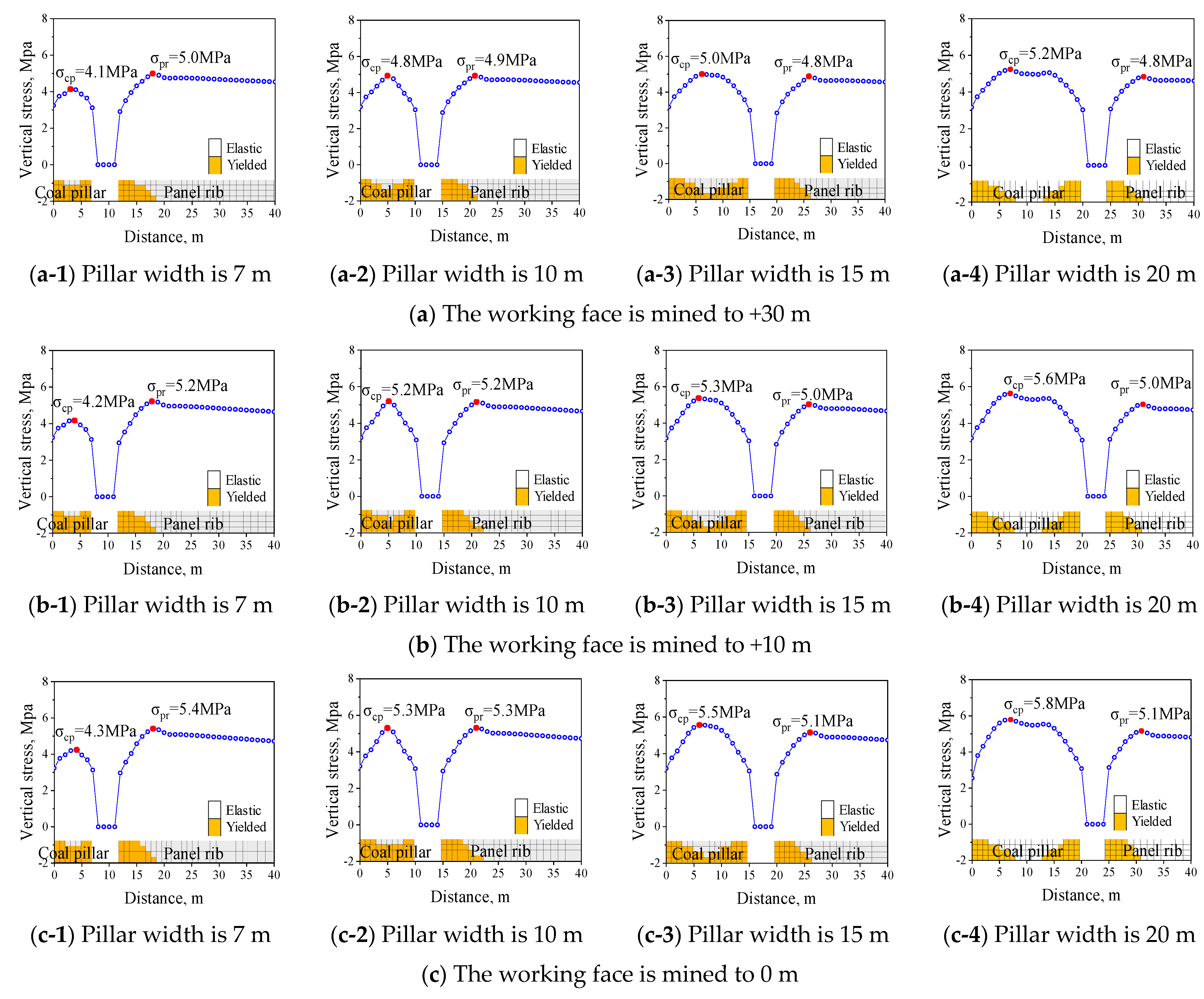

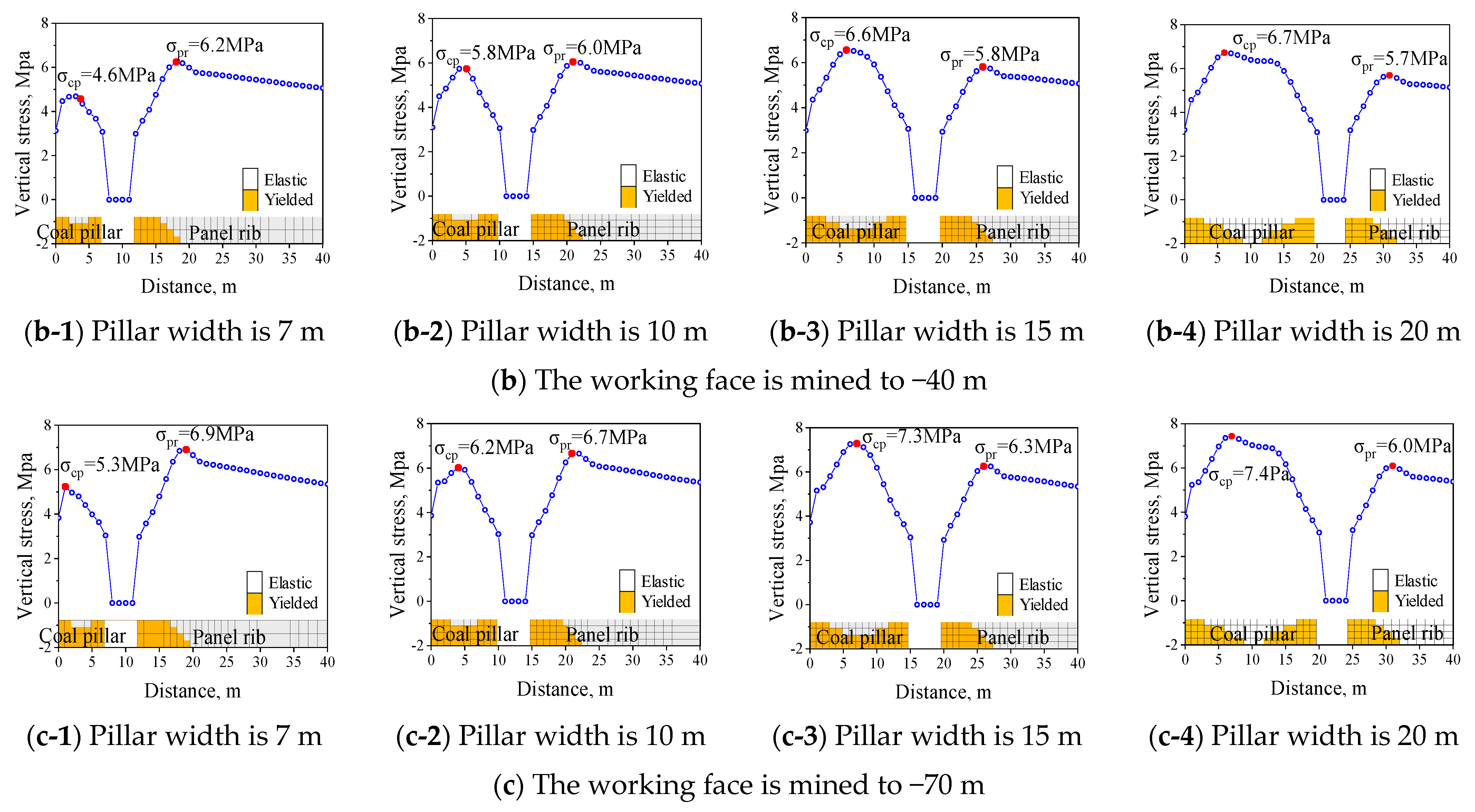

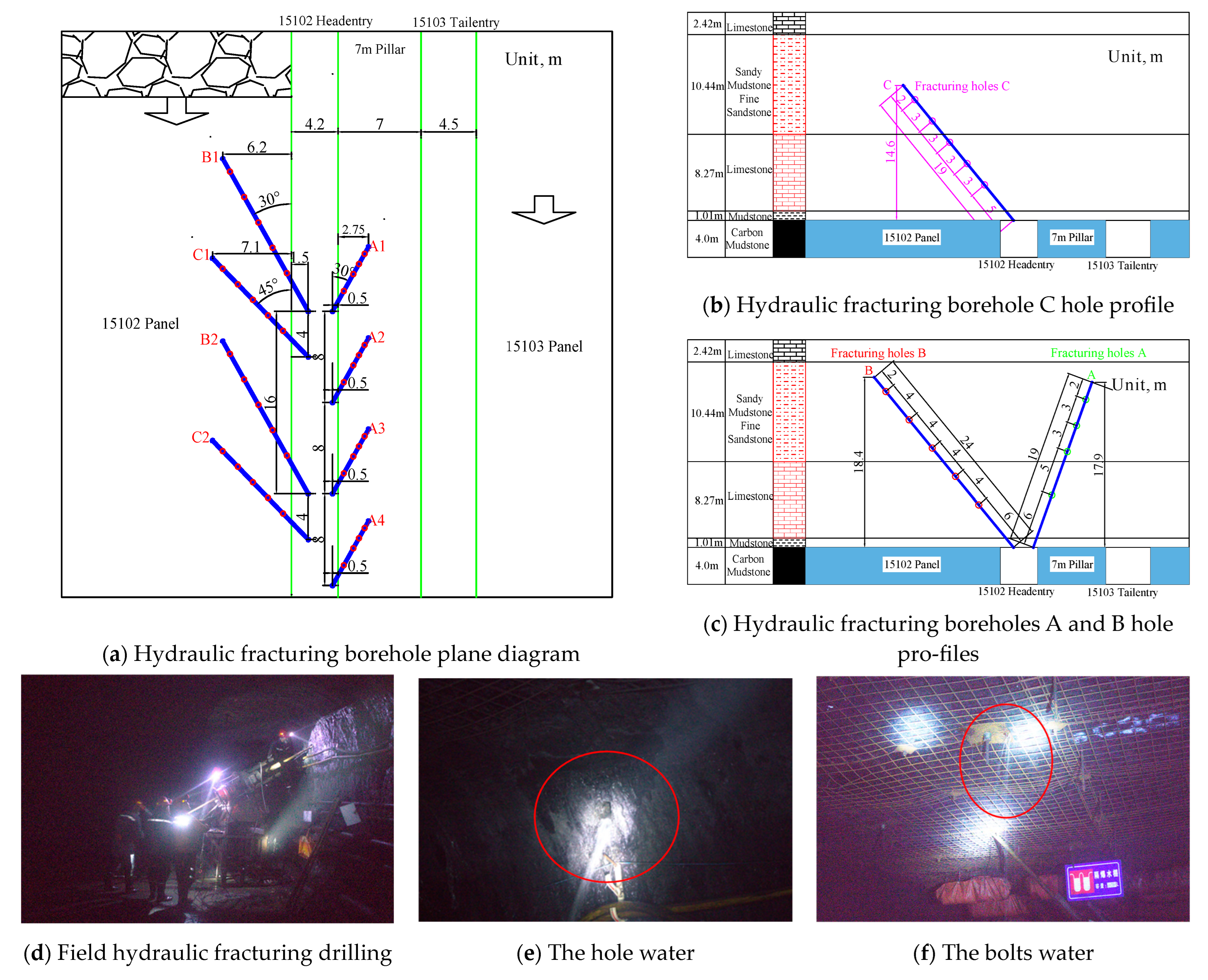


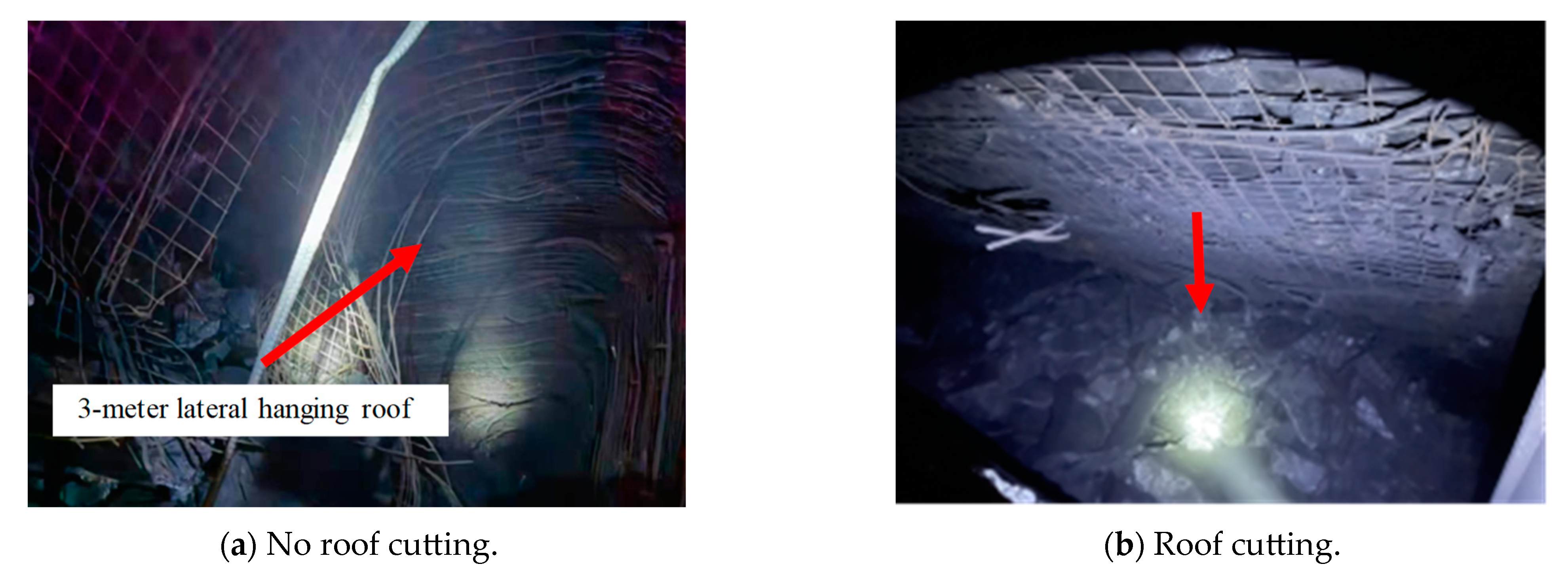
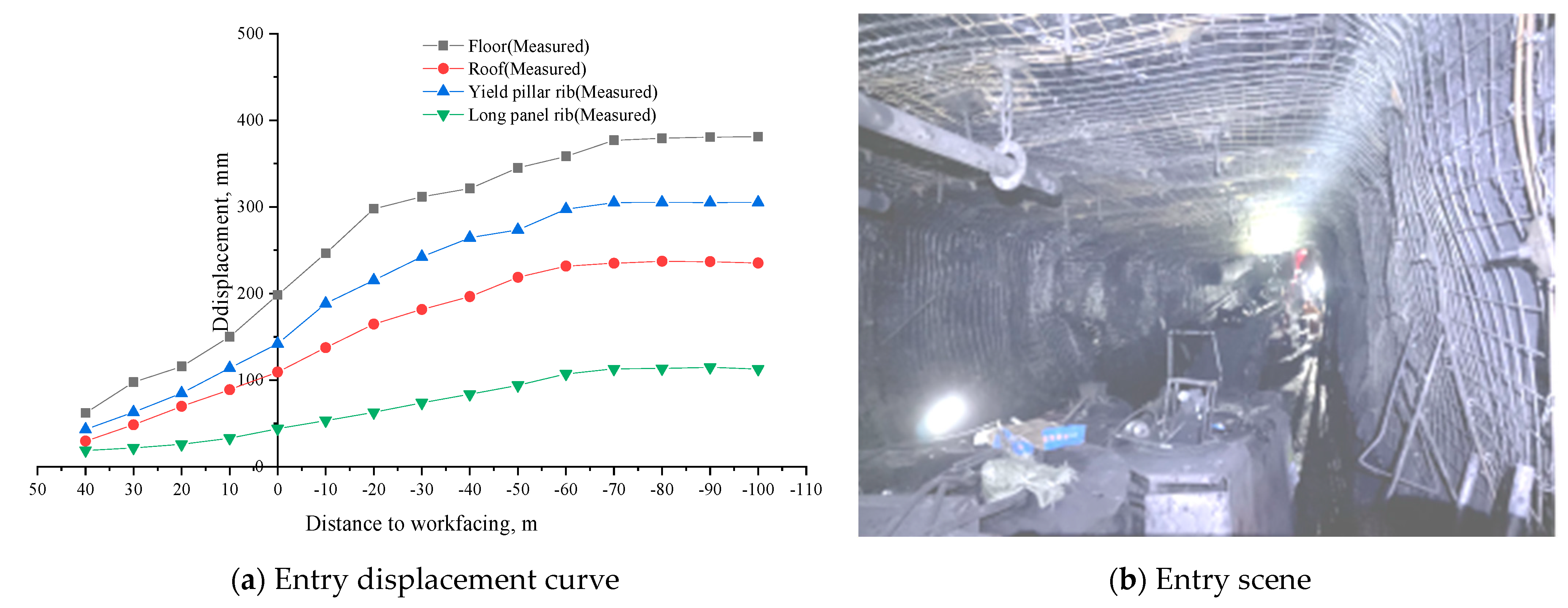
| Lithology | Density, kg/m3 | Bulk Modulus, GPa | Shear Modulus, GPa | Cohesion, MPa | Angle of Internal Friction, ° | Tension Strength, MPa |
|---|---|---|---|---|---|---|
| Overlying strata | 2500 | 8.21 | 6.02 | 2.0 | 30.34 | 0.700 |
| 15# coal seam | 1400 | 6.2 | 0.5 | 0.69 | 29.51 | 0.052 |
| Mudstone | 2510 | 1.6 | 1.0 | 0.796 | 41.76 | 0.642 |
| Sandy mudstone | 2600 | 4.1 | 2.8 | 0.97 | 37.36 | 0.784 |
| Fine sandstone | 2550 | 8.1 | 5.3 | 1.648 | 42.22 | 0.988 |
| Limestone | 2800 | 8.9 | 6.2 | 2.396 | 38.48 | 1.602 |
| Underlying strata | 2500 | 8.21 | 6.02 | 2.0 | 30.34 | 0.700 |
| Strain | Stress, MPa | Strain | Stress, MPa |
|---|---|---|---|
| 0.01 | 0.232066667 | 0.13 | 5.210951515 |
| 0.02 | 0.481010909 | 0.14 | 5.973845161 |
| 0.03 | 0.748743396 | 0.15 | 6.841965517 |
| 0.04 | 1.03747451 | 0.16 | 7.838696296 |
| 0.05 | 1.34977551 | 0.17 | 8.994904 |
| 0.06 | 1.688655319 | 0.18 | 10.3521913 |
| 0.07 | 2.057657778 | 0.19 | 11.96800952 |
| 0.08 | 2.460986047 | 0.2 | 13.924 |
| 0.09 | 2.903663415 | 0.21 | 16.34022353 |
| 0.1 | 3.39174359 | 0.22 | 19.40077333 |
| 0.11 | 3.932589189 | 0.23 | 23.40303077 |
| 0.12 | 4.535245714 | 0.24 | 28.86065455 |
Disclaimer/Publisher’s Note: The statements, opinions and data contained in all publications are solely those of the individual author(s) and contributor(s) and not of MDPI and/or the editor(s). MDPI and/or the editor(s) disclaim responsibility for any injury to people or property resulting from any ideas, methods, instructions or products referred to in the content. |
© 2024 by the authors. Licensee MDPI, Basel, Switzerland. This article is an open access article distributed under the terms and conditions of the Creative Commons Attribution (CC BY) license (https://creativecommons.org/licenses/by/4.0/).
Share and Cite
Wu, W.; Wang, T.; Bai, J.; Liu, J.; Wang, X.; Xu, H.; Feng, G. Failure Characteristics and Cooperative Control Strategies for Gob-Side Entry Driving near an Advancing Working Face: A Case Study. Processes 2024, 12, 1398. https://doi.org/10.3390/pr12071398
Wu W, Wang T, Bai J, Liu J, Wang X, Xu H, Feng G. Failure Characteristics and Cooperative Control Strategies for Gob-Side Entry Driving near an Advancing Working Face: A Case Study. Processes. 2024; 12(7):1398. https://doi.org/10.3390/pr12071398
Chicago/Turabian StyleWu, Wenda, Tianchen Wang, Jianbiao Bai, Jinhu Liu, Xiangyu Wang, Haiyun Xu, and Guorui Feng. 2024. "Failure Characteristics and Cooperative Control Strategies for Gob-Side Entry Driving near an Advancing Working Face: A Case Study" Processes 12, no. 7: 1398. https://doi.org/10.3390/pr12071398
APA StyleWu, W., Wang, T., Bai, J., Liu, J., Wang, X., Xu, H., & Feng, G. (2024). Failure Characteristics and Cooperative Control Strategies for Gob-Side Entry Driving near an Advancing Working Face: A Case Study. Processes, 12(7), 1398. https://doi.org/10.3390/pr12071398







